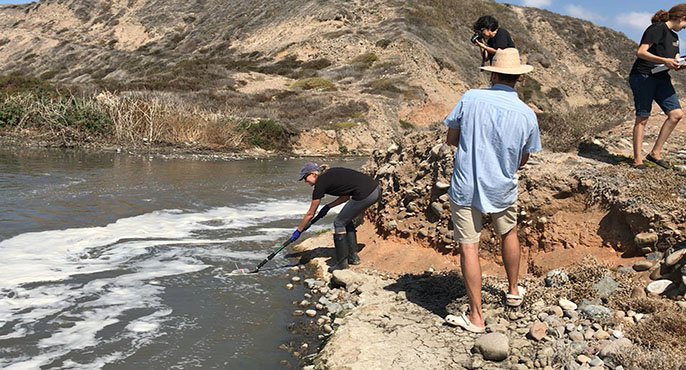Microbial source tracking, or MST, is a DNA-based technology that enables the water-quality management community to determine whether humans or other animal species are responsible for microbial fecal contamination in an aquatic environment. California beach water-quality managers use microbial source tracking – also known as microbial source identification – to gain insights into the degree of health risk posed by fecal contamination at a given site; human fecal matter is far more likely to be infectious to humans than the feces of seagulls, livestock and most other animals.
SCCWRP is an international leader in developing standardized, best-practices methods for conducting microbial source tracking at coastal beaches. SCCWRP co-authored a widely adopted guidance manual in 2013 that outlines best practices for identifying the sources of fecal pollution at California beaches. SCCWRP and its partners are continuing to work to evaluate and optimize various source tracking methods, including for tracking beach fecal contamination signals to an upstream point of origin.

Distinguishing human vs. non-human fecal contamination
Southern California’s beach water-quality management community has made great strides in eliminating fecal contamination from the vast majority of the region’s coastline. But at a small minority of coastal recreational sites across California, persistent fecal contamination signals continue to be detected. Not only have managers struggled to pinpoint the source, but managers also don’t know the degree of health risk it poses to beachgoers. Traditional water-quality testing methods cannot distinguish if contamination is coming from a human vs. non-human source.
Source tracking solves this challenge by zeroing in on specific DNA segments – known as molecular markers – that are uniquely associated with the bacterial community inside a particular animal’s digestive system. Water-quality managers use these gut bacteria – known as fecal indicator bacteria – to determine if fecal contamination is coming from human sewage or livestock manure or bird droppings or another animal. Microbial source tracking also offers insights into which proportions of fecal contamination originated with which host animals.

Management applications for source tracking
SCCWRP and its partners are continuing to explore how to optimally apply source tracking technology and interpret data from source tracking studies. Major research lines include:
- Tracking pervasive contamination in wet weather: During rainfall in Southern California, high levels of fecal contamination wash off the land and through storm drains to the coastal zone. Elevated microbial contamination is so pervasive in wet weather that public health officials issue blanket advisories warning beachgoers not to enter the water for three days after rain. SCCWRP and its partners are using source tracking technology to investigate the sources and origins of this contamination.
- Modeling health risks by site: In case studies that are among the first in the nation, SCCWRP and its partners are evaluating the applicability of a health risk modeling approach known as Quantitative Microbial Risk Assessment (QMRA). This site-specific assessment method uses source tracking methods to quantify fecal contamination levels at a site and estimate health risk from water contact.
- Linking microbial degradation rates to health risk: SCCWRP and its partners are working to better correlate fecal contamination signals with a degree of health risk – a complex equation given that fecal indicator bacteria don’t necessarily degrade at the same rate as the pathogens that infect humans. Researchers are collecting field data and using advanced computer modeling techniques to shed more light on these relationships.

